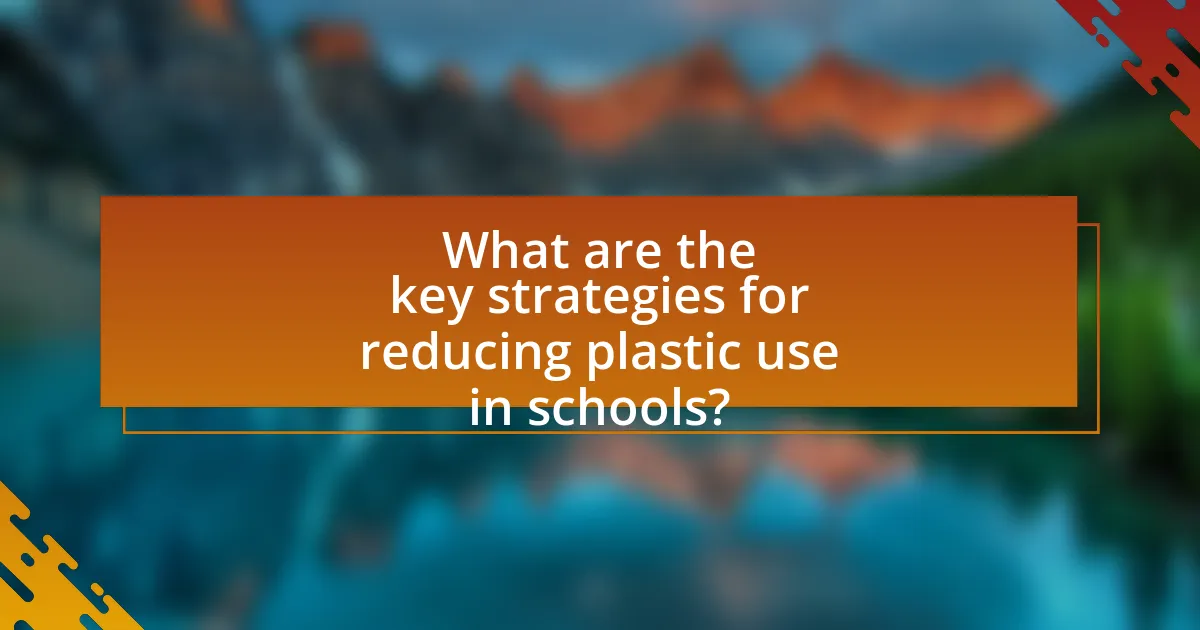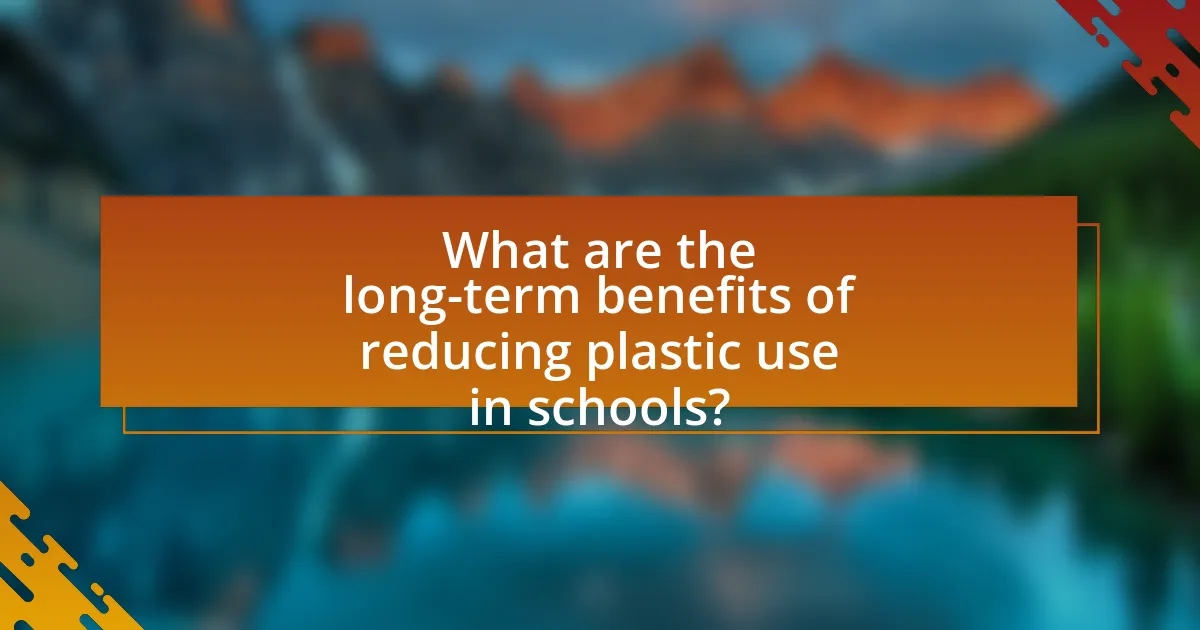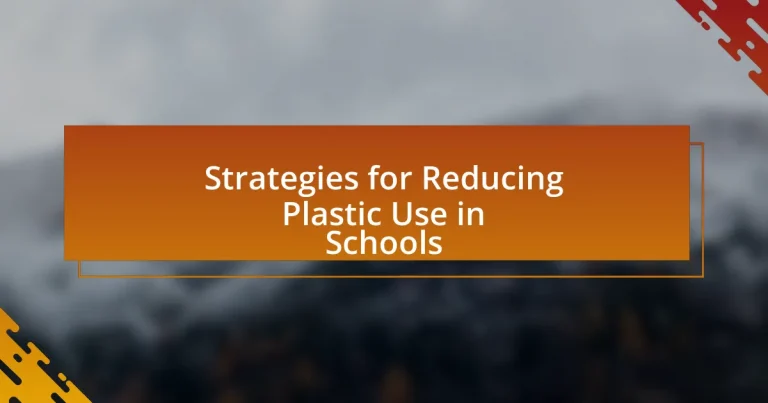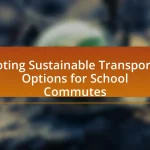The article focuses on strategies for reducing plastic use in schools, emphasizing the importance of implementing reusable materials, promoting recycling programs, and educating students about plastic pollution. Key strategies include conducting audits of current plastic usage, setting clear reduction goals, and engaging stakeholders in the policy-making process. The article outlines practical steps for creating a plastic reduction policy, highlights the role of education in fostering sustainable practices, and discusses the challenges schools face, such as budget constraints and resistance to change. Additionally, it explores the long-term environmental and health benefits of minimizing plastic use, ultimately contributing to a culture of sustainability within educational institutions.

What are the key strategies for reducing plastic use in schools?
Key strategies for reducing plastic use in schools include implementing reusable materials, promoting recycling programs, and educating students about plastic pollution. Schools can adopt reusable containers, utensils, and water bottles to minimize single-use plastics. Additionally, establishing comprehensive recycling initiatives encourages proper waste management and reduces plastic waste. Educational campaigns can raise awareness among students about the environmental impact of plastic, fostering a culture of sustainability. These strategies are supported by studies indicating that schools that adopt such measures significantly decrease their plastic footprint and promote eco-friendly practices among students.
How can schools implement a plastic reduction policy?
Schools can implement a plastic reduction policy by conducting a comprehensive audit of current plastic usage and establishing clear reduction goals. This involves identifying sources of plastic waste, such as single-use items in cafeterias and classrooms, and replacing them with sustainable alternatives like reusable containers and utensils. Research indicates that schools that adopt such measures can significantly decrease plastic waste; for example, a study by the Ellen MacArthur Foundation found that reducing single-use plastics in educational institutions can lead to a 30% reduction in overall plastic consumption. Additionally, engaging students and staff through educational programs about the impacts of plastic waste fosters a culture of sustainability, further supporting the policy’s effectiveness.
What steps are involved in creating a plastic reduction policy?
Creating a plastic reduction policy involves several key steps: assessing current plastic use, setting clear reduction goals, engaging stakeholders, developing actionable strategies, implementing the policy, and monitoring progress.
First, assessing current plastic use requires a comprehensive evaluation of existing practices and identifying areas where plastic can be reduced. Next, setting clear reduction goals provides measurable targets, such as reducing single-use plastics by a specific percentage within a defined timeframe. Engaging stakeholders, including students, staff, and parents, ensures that the policy reflects community values and garners support.
Developing actionable strategies may include initiatives like promoting reusable materials, implementing recycling programs, and organizing educational campaigns about plastic waste. Implementing the policy involves executing the strategies and ensuring compliance among all stakeholders. Finally, monitoring progress through regular evaluations and feedback mechanisms allows for adjustments and improvements to the policy over time.
These steps are essential for effectively reducing plastic use in schools and fostering a sustainable environment.
How can stakeholders be engaged in the policy-making process?
Stakeholders can be engaged in the policy-making process by actively involving them in discussions, consultations, and decision-making activities related to policies aimed at reducing plastic use in schools. This engagement can take the form of public forums, surveys, and collaborative workshops where stakeholders, including teachers, parents, students, and local community members, can voice their opinions and contribute ideas. Research indicates that inclusive stakeholder engagement leads to more effective policy outcomes, as seen in the case of the “Plastic Free Schools” initiative, which successfully reduced plastic waste through community involvement and feedback.
What role does education play in reducing plastic use?
Education plays a crucial role in reducing plastic use by raising awareness and promoting sustainable practices among individuals. Through educational programs, students learn about the environmental impacts of plastic pollution, which can lead to behavioral changes such as reducing single-use plastics and adopting recycling practices. Research indicates that schools implementing environmental education programs see a significant decrease in plastic waste; for instance, a study published in the Journal of Environmental Education found that students exposed to sustainability curricula reduced their plastic consumption by up to 30%. This demonstrates that informed individuals are more likely to make eco-friendly choices, thereby contributing to the reduction of plastic use.
How can teachers incorporate plastic reduction into their curriculum?
Teachers can incorporate plastic reduction into their curriculum by integrating lessons on environmental science, sustainability, and the impact of plastic pollution. For instance, educators can design projects that involve students in researching local plastic waste issues, analyzing data on plastic consumption, and proposing actionable solutions. Studies show that hands-on activities, such as creating art from recycled materials or organizing clean-up events, enhance student engagement and awareness about plastic reduction. Additionally, incorporating discussions on the lifecycle of plastic products and alternatives can foster critical thinking and promote eco-friendly practices among students.
What are effective ways to raise student awareness about plastic pollution?
Effective ways to raise student awareness about plastic pollution include implementing educational programs, organizing clean-up events, and integrating sustainability into the curriculum. Educational programs can provide students with facts about plastic pollution, such as that over 300 million tons of plastic are produced annually, with a significant portion ending up in oceans, harming marine life. Organizing clean-up events allows students to engage directly with their environment, fostering a personal connection to the issue. Additionally, integrating sustainability into the curriculum can help students understand the broader implications of plastic use and encourage critical thinking about solutions. These methods collectively enhance awareness and promote proactive behavior towards reducing plastic pollution.
What alternatives to plastic can schools adopt?
Schools can adopt alternatives to plastic such as stainless steel, glass, and biodegradable materials. Stainless steel water bottles and lunch containers are durable and reusable, significantly reducing single-use plastic waste. Glass containers offer a similar benefit, providing a safe and reusable option for food storage. Additionally, biodegradable materials, including compostable utensils and plates made from plant-based resources, can replace traditional plastic disposables. Research indicates that transitioning to these alternatives can lead to a substantial decrease in plastic consumption, promoting a more sustainable environment within educational institutions.
What types of reusable materials can replace single-use plastics?
Reusable materials that can replace single-use plastics include stainless steel, glass, silicone, and bamboo. Stainless steel is durable and can be used for water bottles and food containers, reducing reliance on plastic. Glass is recyclable and ideal for food storage and beverages, offering a non-toxic alternative. Silicone is flexible and can replace plastic bags and wraps, providing a reusable option for food storage. Bamboo is biodegradable and can be used for utensils and straws, promoting sustainability. These materials not only minimize plastic waste but also contribute to a healthier environment.
How can schools source sustainable products for daily use?
Schools can source sustainable products for daily use by partnering with certified suppliers who specialize in eco-friendly materials. These suppliers often provide products made from recycled or biodegradable materials, which significantly reduce plastic waste. For instance, organizations like Eco-Products and Green Paper Products offer a range of sustainable options, including compostable utensils and recycled paper products. Additionally, schools can implement procurement policies that prioritize sustainability, ensuring that all purchased items meet specific environmental standards. Research indicates that schools adopting such practices can reduce their plastic consumption by up to 50%, contributing to broader environmental goals.

What challenges do schools face in reducing plastic use?
Schools face significant challenges in reducing plastic use, primarily due to budget constraints, lack of awareness, and limited access to alternatives. Budget constraints hinder schools from investing in sustainable materials and infrastructure, as many educational institutions operate under tight financial conditions. Lack of awareness among staff, students, and parents about the environmental impact of plastic contributes to the continued use of single-use plastics. Additionally, limited access to affordable and practical alternatives, such as reusable containers or biodegradable products, makes it difficult for schools to implement effective changes. These factors collectively impede the progress of initiatives aimed at minimizing plastic consumption within educational settings.
What are the common barriers to implementing plastic reduction strategies?
Common barriers to implementing plastic reduction strategies include lack of funding, insufficient awareness, and resistance to change. Schools often face budget constraints that limit their ability to invest in alternative materials or programs aimed at reducing plastic use. Additionally, many stakeholders, including staff and students, may not fully understand the environmental impact of plastic waste, leading to a lack of motivation to adopt new practices. Resistance to change can also stem from established habits and routines, making it difficult to shift towards more sustainable options. These barriers collectively hinder the effective implementation of plastic reduction strategies in educational settings.
How can budget constraints impact plastic reduction efforts?
Budget constraints can significantly hinder plastic reduction efforts by limiting the resources available for implementing sustainable practices. Schools facing tight budgets may prioritize essential services over investments in eco-friendly alternatives, such as reusable materials or recycling programs. For instance, a study by the National School Boards Association found that 60% of school districts reported budget limitations as a barrier to adopting green initiatives. Consequently, without adequate funding, schools may resort to cheaper, single-use plastic products, undermining their efforts to reduce plastic waste.
What resistance might schools encounter from staff or parents?
Schools might encounter resistance from staff or parents regarding strategies for reducing plastic use due to concerns about practicality and effectiveness. Staff may feel that implementing new policies could disrupt established routines or require additional training, while parents might worry about the potential impact on their children’s convenience and access to necessary materials. Research indicates that change management in educational settings often faces pushback when stakeholders perceive a lack of clear benefits or adequate support, highlighting the importance of effective communication and involvement in the decision-making process.
How can schools overcome these challenges?
Schools can overcome challenges in reducing plastic use by implementing comprehensive recycling programs and promoting reusable materials. By establishing clear guidelines for recycling and providing accessible bins, schools can encourage students and staff to participate actively. Research from the Environmental Protection Agency indicates that effective recycling programs can increase recycling rates by up to 50%. Additionally, schools can adopt policies that prioritize the use of reusable items, such as water bottles and lunch containers, which significantly decreases single-use plastic consumption. Implementing educational campaigns about the environmental impact of plastic waste can further engage the school community and foster a culture of sustainability.
What strategies can be employed to secure funding for sustainability initiatives?
To secure funding for sustainability initiatives, organizations can employ strategies such as developing partnerships with local businesses, applying for grants, and engaging in crowdfunding campaigns. Partnerships with local businesses can provide financial support and resources, as companies often seek to enhance their corporate social responsibility profiles. For instance, the Environmental Protection Agency (EPA) offers various grants for sustainability projects, which can be accessed through a well-prepared proposal that outlines the project’s impact and feasibility. Additionally, crowdfunding platforms like Kickstarter or GoFundMe allow individuals and organizations to raise funds directly from the community, tapping into public interest in sustainability. These strategies have been successfully utilized in various projects, demonstrating their effectiveness in securing necessary funding.
How can schools build a supportive community around plastic reduction?
Schools can build a supportive community around plastic reduction by implementing educational programs that engage students, staff, and parents in sustainability initiatives. These programs can include workshops, campaigns, and challenges that promote awareness of plastic pollution and encourage the adoption of alternatives to single-use plastics. For instance, a study by the Ellen MacArthur Foundation highlights that educational initiatives can significantly increase community involvement and commitment to reducing plastic waste. By fostering collaboration among students, teachers, and families, schools can create a culture of sustainability that reinforces the importance of reducing plastic use and encourages collective action.

What are the long-term benefits of reducing plastic use in schools?
Reducing plastic use in schools leads to significant long-term environmental and health benefits. By minimizing plastic consumption, schools contribute to decreased plastic pollution, which is critical as an estimated 8 million tons of plastic enter oceans annually, harming marine life and ecosystems. Additionally, reducing plastic exposure can improve student health, as certain plastics contain harmful chemicals linked to developmental issues and endocrine disruption. Furthermore, schools that adopt sustainable practices can foster a culture of environmental responsibility among students, promoting lifelong habits that benefit society and the planet. This shift can also lead to cost savings over time, as schools invest in reusable materials rather than single-use plastics, ultimately supporting a more sustainable future.
How does reducing plastic use impact the environment?
Reducing plastic use significantly benefits the environment by decreasing pollution and conserving natural resources. When plastic consumption is lowered, less plastic waste enters landfills and oceans, which helps protect wildlife and ecosystems. For instance, according to a study published in the journal Science, approximately 8 million metric tons of plastic waste end up in the oceans each year, harming marine life and disrupting food chains. Additionally, reducing plastic production lowers greenhouse gas emissions associated with its manufacturing, contributing to climate change mitigation. Thus, minimizing plastic use directly leads to a healthier environment and sustainable resource management.
What are the ecological benefits of minimizing plastic waste?
Minimizing plastic waste significantly benefits ecosystems by reducing pollution and protecting wildlife. When plastic waste is decreased, fewer materials enter oceans and landfills, which helps prevent the ingestion and entanglement of marine and terrestrial animals. According to a study published in the journal “Science,” an estimated 1 million marine creatures die each year due to plastic pollution. Additionally, reducing plastic waste contributes to lower greenhouse gas emissions, as the production and incineration of plastics are major sources of carbon emissions. The United Nations Environment Programme reported that transitioning to sustainable alternatives can reduce plastic pollution by up to 80% by 2040, thereby enhancing biodiversity and ecosystem health.
How does plastic reduction contribute to a school’s sustainability goals?
Plastic reduction significantly contributes to a school’s sustainability goals by minimizing waste and decreasing environmental impact. Schools that implement plastic reduction strategies can lower their carbon footprint, as plastic production and disposal are major contributors to greenhouse gas emissions. For instance, a study by the Ellen MacArthur Foundation found that reducing plastic use can lead to a decrease in plastic waste entering landfills and oceans, which is crucial for protecting ecosystems. Additionally, schools that adopt reusable materials and promote recycling can foster a culture of sustainability among students, encouraging lifelong environmentally responsible behaviors.
What positive effects can reducing plastic have on student health?
Reducing plastic can significantly improve student health by decreasing exposure to harmful chemicals found in plastic products. Studies indicate that plastics can leach toxic substances, such as bisphenol A (BPA) and phthalates, which are linked to various health issues, including hormonal disruptions and developmental problems in children. By minimizing plastic use in schools, students are less likely to encounter these harmful chemicals, leading to better overall health outcomes. Additionally, reducing plastic waste promotes a cleaner environment, which is associated with improved mental well-being and physical health among students, as a cleaner environment can enhance focus and reduce stress levels.
How can reducing plastic exposure improve student well-being?
Reducing plastic exposure can significantly improve student well-being by minimizing health risks associated with plastic chemicals. Studies indicate that exposure to harmful substances found in plastics, such as bisphenol A (BPA) and phthalates, can lead to adverse health effects, including hormonal disruptions and increased anxiety levels. For instance, research published in the journal Environmental Health Perspectives found that children with higher levels of BPA exposure exhibited behavioral issues, including increased hyperactivity and anxiety. By decreasing plastic use in schools, students can experience a healthier environment, which contributes to better mental and physical health outcomes.
What role does a healthy environment play in academic performance?
A healthy environment significantly enhances academic performance by promoting better physical and mental well-being among students. Research indicates that students in clean, well-maintained, and resource-rich environments exhibit higher levels of concentration, engagement, and overall academic achievement. For instance, a study published in the Journal of Environmental Psychology found that improved air quality and natural lighting in classrooms can lead to a 15% increase in student performance. Additionally, environments that prioritize sustainability, such as reducing plastic use, contribute to a sense of community and responsibility, further motivating students to excel academically.
What practical tips can schools implement to reduce plastic use effectively?
Schools can effectively reduce plastic use by implementing a comprehensive recycling program, encouraging the use of reusable materials, and promoting awareness among students and staff. A recycling program can include clearly labeled bins for different types of waste, which has been shown to increase recycling rates by up to 30% in educational settings. Encouraging the use of reusable materials, such as water bottles and lunch containers, can significantly decrease single-use plastic consumption; studies indicate that switching to reusable items can reduce plastic waste by over 50%. Additionally, schools can promote awareness through educational campaigns that inform students about the environmental impact of plastic waste, leading to more sustainable behaviors.
How can schools create a successful recycling program?
Schools can create a successful recycling program by implementing a structured plan that includes education, accessibility, and community involvement. Educating students and staff about the importance of recycling and proper sorting techniques fosters a culture of sustainability. Providing clearly labeled recycling bins in convenient locations increases participation, as studies show that accessibility directly correlates with recycling rates. Engaging the community through events and partnerships with local recycling organizations can enhance awareness and support. Research indicates that schools with comprehensive recycling programs can divert up to 75% of waste from landfills, demonstrating the effectiveness of these strategies.
What are some simple changes that can lead to significant plastic reduction?
Implementing reusable containers and utensils in schools can lead to significant plastic reduction. By encouraging students to use stainless steel or glass water bottles instead of single-use plastic bottles, schools can decrease plastic waste substantially. A study by the Container Recycling Institute found that if every American used a reusable water bottle, it could eliminate over 1.5 million tons of plastic waste annually. Additionally, replacing plastic straws and cutlery with compostable or reusable alternatives can further minimize plastic consumption. These simple changes not only reduce plastic waste but also promote sustainable habits among students.


